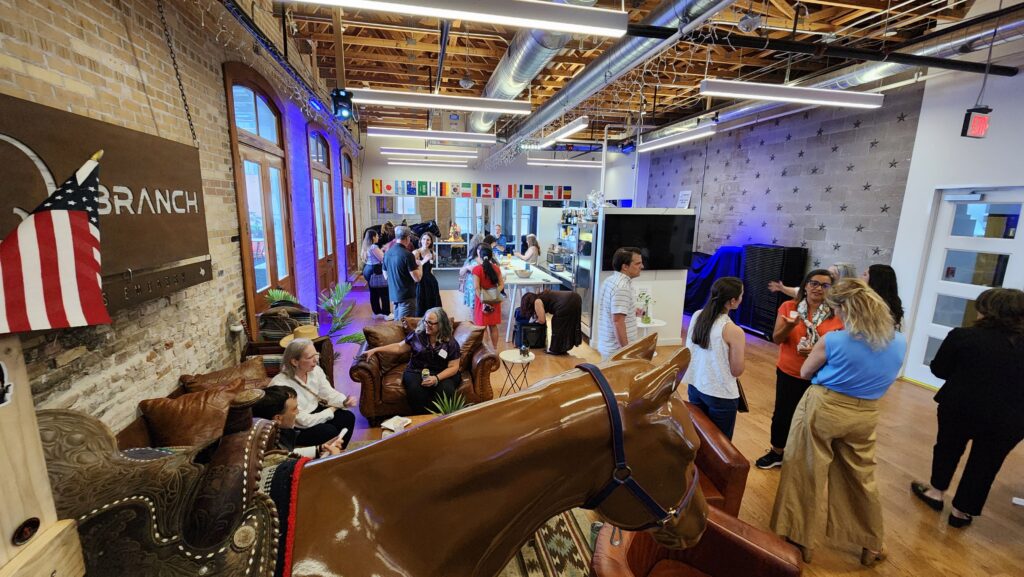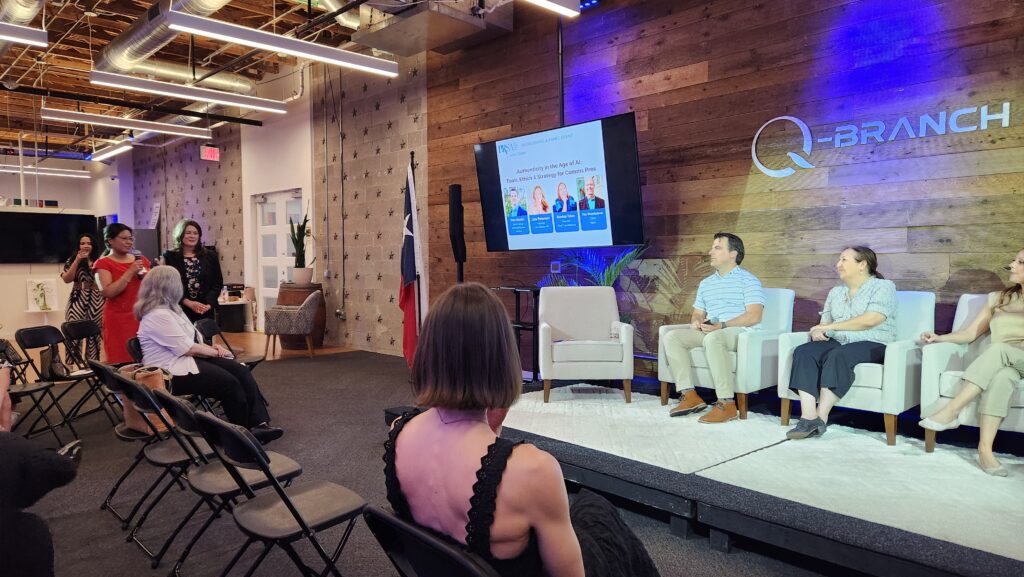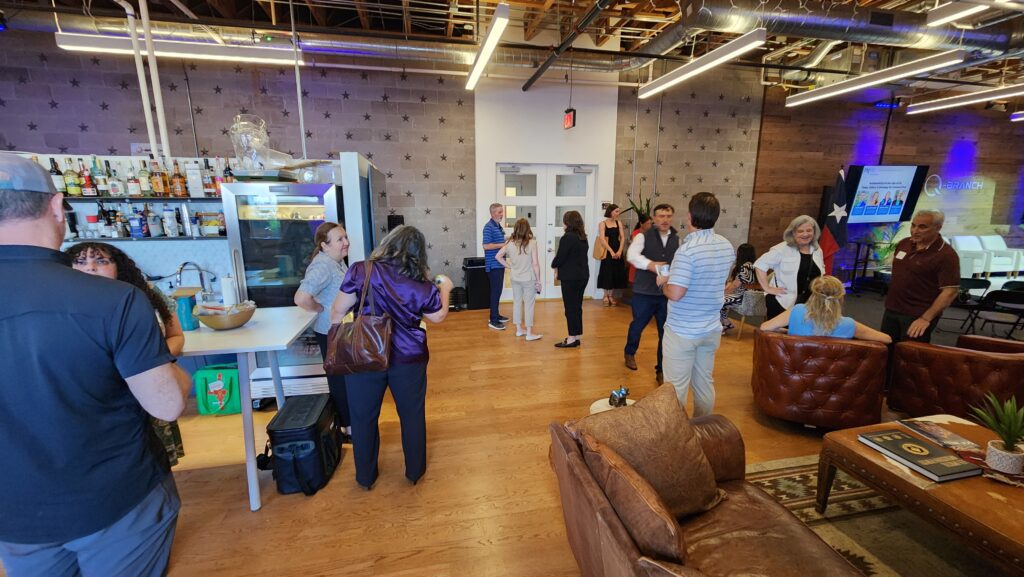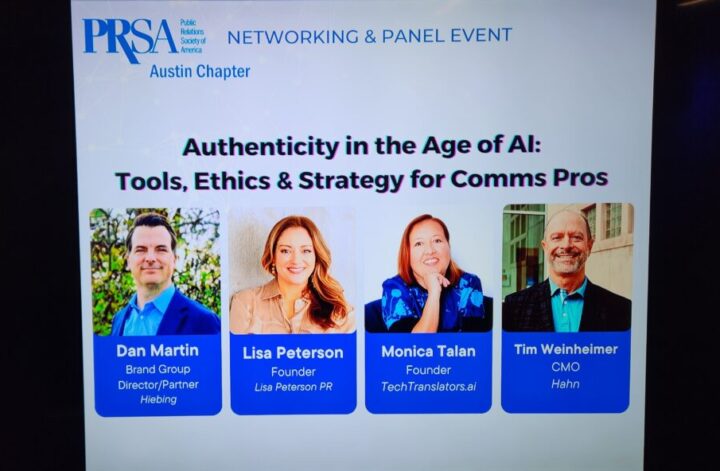On Thursday, May 22, I joined fellow communicators at Q-Branch in Downtown Austin for an event hosted by the PRSA Austin Chapter—an evening that promised insight and inspiration, and absolutely delivered. The focus? The evolving role of artificial intelligence in public relations and communications. It was a dynamic and thought-provoking panel that confirmed familiar ideas and concerns while highlighting new AI opportunities and challenges.
Moderated by Anne Lasseigne Tiedt, APR, the panel featured four industry professionals: Monica Talan (TechTranslators.ai), Tim Weinheimer (Hahn), Dan Martin (Hiebing), and Lisa Peterson (Lisa Peterson PR). Each panelist offered a unique perspective—from tech backgrounds to data analytics, agency marketing services to media relations—on how AI is transforming how we communicate, collaborate, and connect with our audiences.


We’re All in the Diving Stage of AI
We’re still in the early phases of AI adoption across the communications field. For most professionals, this stage feels like diving headfirst into a new and unfamiliar pool—testing the waters, learning how to swim, and figuring out what works. While some have embraced experimentation, many are still building foundational knowledge of what these tools can realistically do.
Key advice for beginners:
- Start small. Choose one platform or tool—like ChatGPT or Jasper—and focus your efforts there. Spreading yourself across multiple platforms too quickly can lead to burnout or overwhelm.
- Choose tools based on specific needs, not hype. Don’t chase the latest AI trend just because it’s popular. Evaluate platforms based on how well they serve your actual goals—whether that’s content creation, analytics, or media monitoring.
- Be patient with the process. AI isn’t perfect, and it’s not meant to be. Expect to iterate, experiment, and occasionally be wrong. Mistakes are part of building fluency.
Smarter Prompting = Better Output
One of the clearest takeaways from the panel was this: how you ask determines what you get. Generative AI is only as good as the information and direction you feed it. Prompting with clarity, structure, and purpose unlocks far more valuable results.
Prompting tips from the panel:
- Lead with action verbs. Use prompts that begin with “Identify,” “Describe,” “Draft,” or “Explain” to frame your request with intention and clarity.
- Provide detailed context. Include background information, target audience insights, tone preferences, or specific data points to help the AI tailor its response.
- Mirror real-world PR tasks. Ask the AI to act like a publicist, strategist, or journalist. Prompts like “Write a pitch for a sustainability-focused product launch” are more effective than vague requests.
- Define terms and parameters. Be specific about what key terms mean in your context, and what kind of output you’re expecting. The more clearly you communicate the boundaries, the better the results.


Building an AI-Native Company Culture
Adopting AI isn’t just about using new tools—it’s about fostering a culture that understands, embraces, and responsibly integrates them. Successful teams treat AI not as a gimmick, but as a mindset shift that influences internal workflows, client services, and creative approaches.
Best practices for shaping an AI-forward culture:
- Offer internal training. Empower your team with training sessions on your chosen tools and reinforce ethical, practical use cases. Comfort with AI starts with education.
- Establish clear expectations. Define when and how AI should be used across departments or client accounts. Include expectations in onboarding and team meetings.
- Be open with clients. Disclose the use of AI in proposals, scopes of work, and deliverables. Transparency builds trust—and can also position you as a tech-savvy partner.
- Promote AI as a creative partner. Encourage your team to view AI not just as a shortcut, but as a tool that can amplify creative thinking, reduce repetitive tasks, and free up bandwidth for brainstorming big ideas.
- Keep policies flexible and current. AI is evolving quickly, and so should your internal guidance. Set regular reviews of your AI policy to keep up with new tools, regulations, and ethical considerations.
Ethics, Guidelines, and Guardrails
Responsible AI usage begins with leadership and is reinforced through clear protocols. As exciting as AI can be, it raises serious questions about data privacy, intellectual property, and misinformation. Without strong guardrails, you risk missteps that can erode trust or even create legal exposure.
Guiding principles to implement:
- Protect sensitive information. Never input proprietary or client-confidential data into AI tools without proper safeguards. Assume your data may be stored or seen.
- Create boundaries. Outline what employees are allowed and not allowed to do with AI tools. Provide examples to reduce ambiguity.
- Implement data governance. Review and audit AI tool outputs regularly to ensure accuracy, ethical alignment, and compliance with organizational standards.
- Prioritize education. Make AI awareness part of ongoing internal communication. Share resources on ethical AI use, and host team discussions to surface concerns and suggestions.
- Watch for over-reliance. AI often produces authoritative-sounding answers that can be inaccurate, generic, or misleading. Human critical thinking and fact-checking must always remain central.
Preserving Brand Voice in an AI World
While AI can help generate content quickly, it cannot—and should not—replicate the authenticity and nuance of your brand voice. Consistency, tone, and emotional connection still require a human touch.
To protect your brand’s identity:
- Always include human review. No AI-generated content should go out without a final pass from a real person. This ensures quality, accuracy, and brand alignment.
- Check for tone and authenticity. Even if an AI-written paragraph sounds polished, it might miss the tone your brand is known for. Use it as a draft, not the final product.
- Stay mission-driven. When in doubt, revisit your brand’s core values and intended audience. Let those guide the use and limitations of AI in storytelling.
- Let AI support, not lead. Use AI to brainstorm angles, draft outlines, or accelerate research—but keep the final storytelling in the hands of those who understand your brand best.


Efficiency, Not Replacement
AI shines when it comes to saving time and streamlining repetitive tasks. It’s not about eliminating human jobs—it’s about freeing up human energy for higher-level strategy, creativity, and relationship-building.
Where AI can enhance your daily work:
- Speeding up research. Use AI tools to gather deep research, summaries, media contacts, or compile backgrounders.
- Jumpstarting creativity. Let it assist in brainstorming sessions, headline ideas, mock up visuals, or campaign themes.
- Drafting foundational content. Whether it’s pitches, social copy, or client emails, AI can draft a first draft to edit from.
- Managing personal tasks. Use AI for scheduling, travel planning, reminders, and voice-enabled tools that simplify your day-to-day.
- Supporting accessibility. Voice-to-text tools or audio assistants powered by AI can support more inclusive workflows and adapt to people’s communication styles.
AI’s Impact on Jobs and the Future of Work
The conversation around AI and employment wasn’t alarmist—it was practical. Like past tech shifts, AI will reshape the workforce, but not uniformly. The most adaptable professionals will be those who stay curious, keep learning, and lean into what makes them uniquely human.
Here’s what to watch:
- Entry-level jobs may evolve. Tasks that once assigned to junior staff—like copywriting, data analysis, or basic research—are being handled by AI. This makes entry having real-world experience, creativity, and initiative more important than ever.
- New roles are emerging. Expect to see jobs focused on prompt engineering, AI strategy and integration, technology specialists, and ethics oversight. These will require both technical fluency and communication savvy.
- Soft skills are still critical. Emotional intelligence, storytelling, public speaking, client management, public outreach, and big-picture thinking remain highly valuable—AI can’t replicate those.
- AI creates a skills gap—and an opportunity. Those who upskill now will have an edge, whether in applying for jobs, leading teams, or shaping innovation.
- Hiring is changing. With both candidates and employers using AI in applications and resume screening, there’s a growing need for transparency and fairness in recruitment practices in an overly competitive market.
Final Thoughts
The biggest takeaway? AI is not the “end all, be all”—it’s a tool and process. This panel reminded me that the future of PR isn’t about replacing humans—it’s about amplifying what makes us irreplaceable.
Whether you’re integrating AI to save time, spark ideas, or elevate client service, remember: authenticity, transparency, and strategic thinking still rule. Stay curious, stay human—and keep diving until you’re swimming!
Additional PR and AI Videos:
*Content was generated with AI based on my notes and direction, then edited and refined by me for accuracy.




